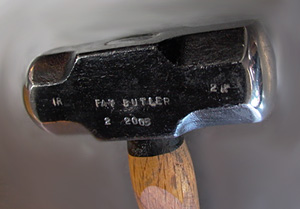Fay Butler Fab/Metal Shaping
Making a Bumping Hammer
|
The least expensive, most common bumping hammer (your grandfather's 3-pound sledge hammer, for example). This one has a 1" radius on one side, 2" on the other.
|
First you need some sort of hammer. I recommend that you find an old 2 or 3 pound hand sledge hammer with a wooden handle. If you do not have one lying around in the garage, or from a friend, then you might consider purchasing one from some cheap tool store, generally for around $10. This hammer will need modifying. At least one hammer surface will need to have the edges radius off, as they will dig in and leave marks if not smoothed out. If you don’t have any sort of sander to do this, I would recommend that you find a file, a 10-inch mill file preferably, and file the edge radius in. A Nickelson or Simonds are the best made files, Nickleson is the company that originated the file profile and really no one has effectively copied it. If you have good sanding and buffing equipment, then I would recommend besides sanding in a good edge radius, you might consider dressing the entire hammer work surface. One end of the hand sledge hammer sand to a 2-inch radius and the other end sand to a 1-inch radius. Then buff the entire work surface as the smoother the surface is the less scratch marks will be transferred. |
 |
©2005-2007 Fay Butler